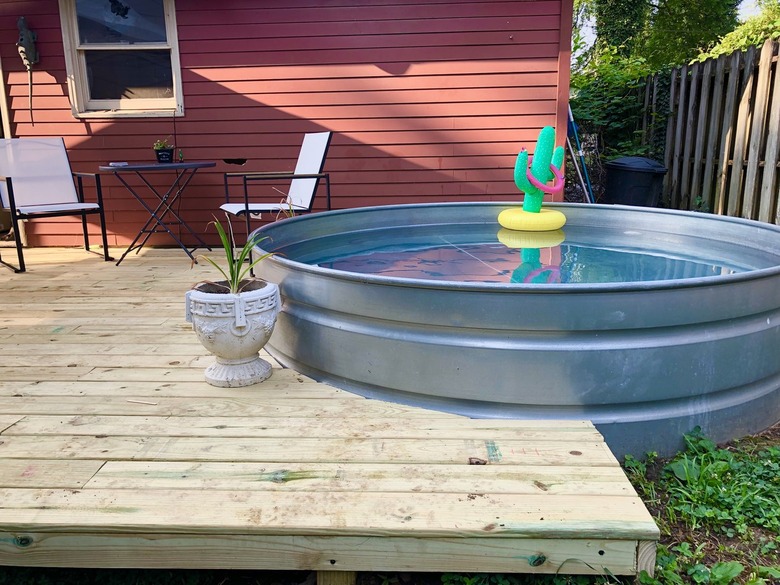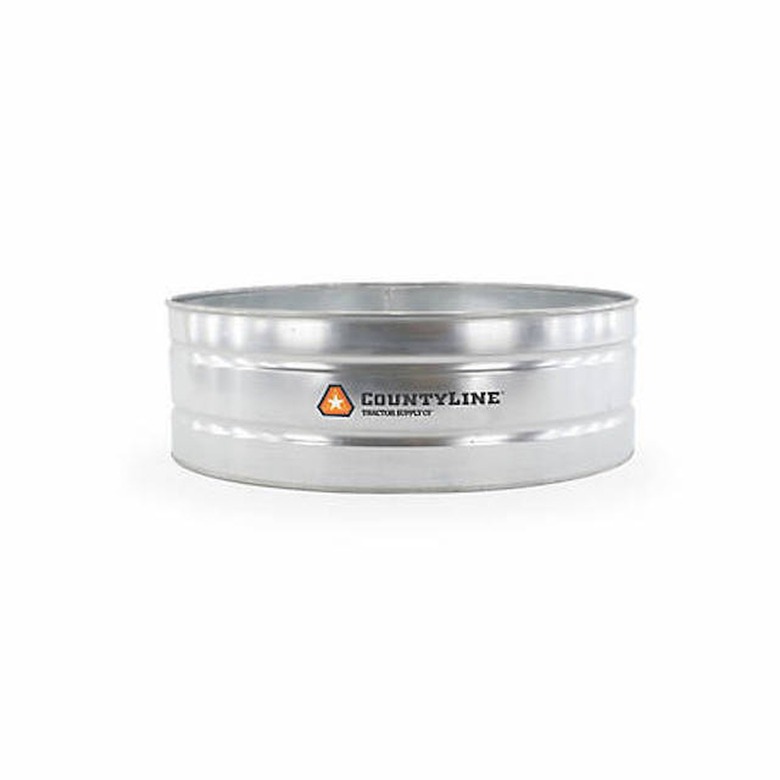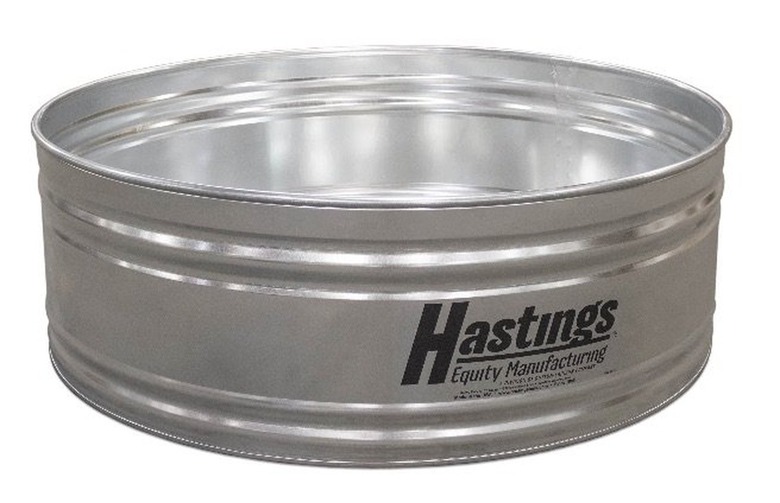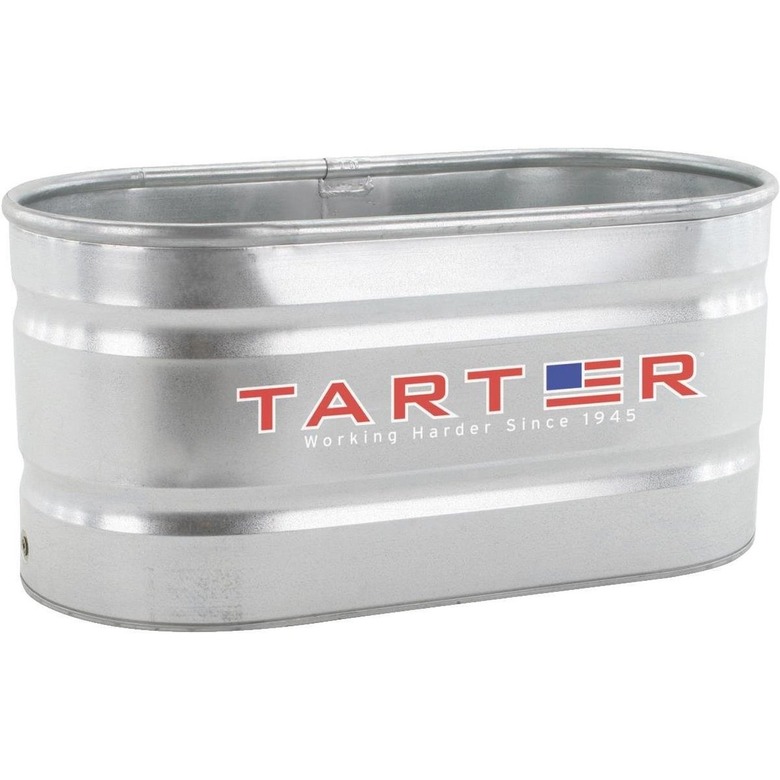Everything You Need For A DIY Stock Tank Pool
We may receive a commission on purchases made from links.
You can be attracted to the idea of building a DIY stock tank pool for a number of reasons. You may like the fact that it's a budget-friendly alternative to a conventional (or unconventional) swimming pool. You may appreciate the fact that it will fit in places that a conventional pool won't, or you may simply be jealous that the kids have a wading pool and you don't. Of all swimming pool options, a stock tank pool is far and away the least pretentious, being basically a wading pool for adults.
Although stock tank pools are trendy, not everyone knows what they are, and if that's you, here's the scoop: A stock tank is a large, galvanized steel watering trough for livestock. Stock tanks come in various sizes, and if you have one that's large enough, you can fill it with water, and voilá — it's a swimming pool (more properly, a soaking tub). It's not quite that easy, of course, because you still need to install a pool filter, a pool pump, and a heater if desired. You also need to maintain the water just as you would if it were an actual swimming pool or spa, but if you're the DIY type, all of this is easy to do.
A stock tank pool is definitely the least expensive pool you can buy, and if all you want to use it for is cooling off on a hot day, you can build one for under $1,000. Stock tanks are deep enough to allow you to immerse your body but not deep enough to be dangerous for kids, so you can throw away that vinyl kiddie pool. Perhaps best of all, your DIY stock tank pool is easy to disassemble, move and put away for the winter.
Stock Tank Pool Size
Stock Tank Pool Size
Galvanized steel stock tanks come in two shapes: round and oval. There are pros and cons to both types, and these should be considered when determining which shape and size is right for you and your family. Round stock tanks, for example, are available in a range of sizes, with the most common being 6 feet and 8 feet in diameter. Round stock tank pools are best for families, particularly the 8-foot tank, which is roomy enough for four to five people. If you can't find one at your local feed store, they are readily available online, particularly at Tractor Supply.
While the round-shaped stock tank pools are popular because they are most similar to an above-ground pool and can fit more people, an oval tank is good for singles and couples. Common oval-shaped stock tank pool sizes are 3 x 8 feet, 2 x 6 feet, and 2 x 4 feet. Some people like an oval tank for the isolation and ability to relax by themselves, and 6 to 8 feet is a perfect length in which to stretch out. Although they are shaped differently, both round and oval stock tanks have a depth of approximately 2 feet.
Filter Pump and Related Parts
Just like with a typical above-ground pool, a DIY stock tank pool requires a filter pump to keep water circulating and to filter out debris. To install a filter pump, you should need only four parts, the first and obviously most important being the actual filter pump itself. The pump most commonly used by DIY stock tank pool owners is the 1,500 GPH Intex filter pump, which can be found for under $200. If you have a smaller tank and want to save a little money, you can try a 1,000 GPH Intex pump, available for just over $100. To be on the safe side, though, opt for the larger pump regardless of tank size.
You'll also need a threaded inlet strainer assembly, which connects the hoses and prevents large debris from entering the pump. This can be found at a local pool store or online for a cost between $50 and $100. You'll also need a couple of plunger valves, one for the inlet and one for the outlet. They are shutoff valves to keep water from escaping the pool when servicing or changing the pump and come in packs of two for about $20 for the pair. Finally, you need a hose to connect the pump to the pool, and you should be able to get all you need for $20.
Installing the Filter Pump
Installing the Filter Pump
You need to drill two holes into the side of the stock tank to make your DIY pool, and for this, you need a drill and a hole saw with an arbor, which is a pilot bit that prevents the saw from wandering. Hole size differs depending on the parts you purchase, but most stock pools require 2 3/4-inch holes, so that's the size of saw you need, and you'll be able to find one online or at any hardware store or home improvement outlet. Be sure to get one designed for cutting metal and double-check the size you need before making your purchase — because the hole will be very difficult to seal if it's too big.
Most stock tanks have ribbing that runs vertically or horizontally, and the ones with horizontal ribbing are the easiest to convert into pools. You'll need to drill both inlet and outlet holes, and if you position them midway between adjacent ribs, you should be able to seal the valve fittings, which have rubber gaskets, by hand. If you have to drill a hole that straddles a rib, you'll need plenty of silicone sealant to make the gasket seals watertight. Drill the inlet hole as close to the bottom of the tank as possible and the outlet hole as close to the top as possible.
After connecting the pool pump to the pool and securing the hoses, you need to plug into the pump, and because the pump is circulating water, you need to plug it into a ground-fault circuit-interrupter (GFCI) outlet. If you have an outlet on the side of the house but it isn't a GFCI, it's easy to replace. An alternative for temporary use is to plug the pump into a GFCI extension cord, a $30 investment.
Stock Tank Pool Maintenance
Stock Tank Pool Maintenance
Like the water in any pool, the water in a stock tank pool must be circulated and sanitized to keep algae and bacteria under control and prevent it from turning cloudy or discolored. By hooking up the pool pump, you've already solved the circulation problem, so now all you have to do is add chlorine, right? Actually, it's not quite that simple because for the chlorine to be effective, you also have to regulate the pH and total alkalinity of the water, and you do that the same way you would for any pool.
Testing the pool water for pH, total alkalinity and free chlorine levels is the first step in routine pool maintenance, and you can do that with test strips or a test kit with chemicals that turn various colors. These testing supplies are inexpensive, costing less than $10. You first test the pH, which should be between 7.2 and 7.6, and the total alkalinity, which should be between 80 and 120 parts per million (ppm). Lower the pH if necessary by adding dry acid to the water and raise it by adding baking soda. If you need to raise total alkalinity as well as pH, add soda ash instead of baking soda.
Once you've balanced the pH and alkalinity, the next step in maintaining the water quality in your stock tank pool is to test for free chlorine, which should be between 1 and 3 ppm, and add more if necessary. Because a stock tank pool is small in comparison to other types of pools and galvanized metal is subject to corrosion, you want to avoid fast-release chlorine. Opt instead for slow-release chlorine tablets with a stabilizer to prevent the chlorine from degrading in the sun and use a floating chlorine dispenser to hold them. All of these pool supplies are readily available at stores and online.
DIY Stock Tank Pool Heater
DIY Stock Tank Pool Heater
Whether you just want to take the chill out of the water or you want a full-on spa experience, it's easy to add heat to your stock tank pool water, and no, you don't need to invest in a pool heater. You need an inexpensive outdoor propane on-demand water heater, a 5-gallon tank full of propane, a circulation pump, an inline filter, and some hoses and fittings. Specifically, you'll need 1/2-inch black poly pipe, one set of three brass garden hose menders with 1/2-inch barb connections, and two brass spigots with through fittings. You'll also need a 7/8-inch hole saw to drill inlet and outlet holes in the tank. All of this is going to set you back less than $500.
After mounting the water heater on a wall, fence, or post close to the pool and connecting it to the propane tank with barbed connectors, you run the hot water line to a predrilled hole near the top of the tank into which you've installed a spigot. The cold-water line goes from a spigot mounted near the bottom of the tank to the filter and then to the circulation pump, which is mounted near the water heater, and finally to the water heater's inlet port. When you attach the poly pipe to one of the barbed connectors, secure it with a hose clamp and you won't have any leaks.
Problems With Stock Tank Pools
Problems With Stock Tank Pools
Your DIY stock tank pool won't be problem-free. Despite your best maintenance efforts, buildup is likely to collect on the surface of the water, and it can turn slimy. Prevent this by skimming the water every time you use the pool. Another potential problem is rust because a tank made of metal — even though it's galvanized — is vulnerable to acidic water and chlorine. This is another reason you have to regulate pH and use chlorine tablets in a floating dispenser rather than pouring chlorine directly into the pool.
Mosquitoes can be a problem, and although you can control them by keeping the water circulating, you might want to surround the tub with mosquito netting, which actually adds to the charm of your backyard oasis. Putting the tub in an open space rather than surrounded by trees and bushes also helps keep down the mosquito population, but beware — the metal tank can get dangerously hot in the full sun, so you'll probably want to provide some shade even if it's just an umbrella.
Finally, investing in a solar pool cover may be a way to keep the water warm without installing a heater depending on the outside temperature. It will prevent water loss from evaporation and will discourage mosquitoes.
The Best Stock Tanks for a DIY Pool
The Best Stock Tanks for a DIY Pool
Ready to get started? Here are a few of the best stock tanks to kick off your DIY pool journal.
1. CountyLine Round Galvanized Stock Tank, $399.99



